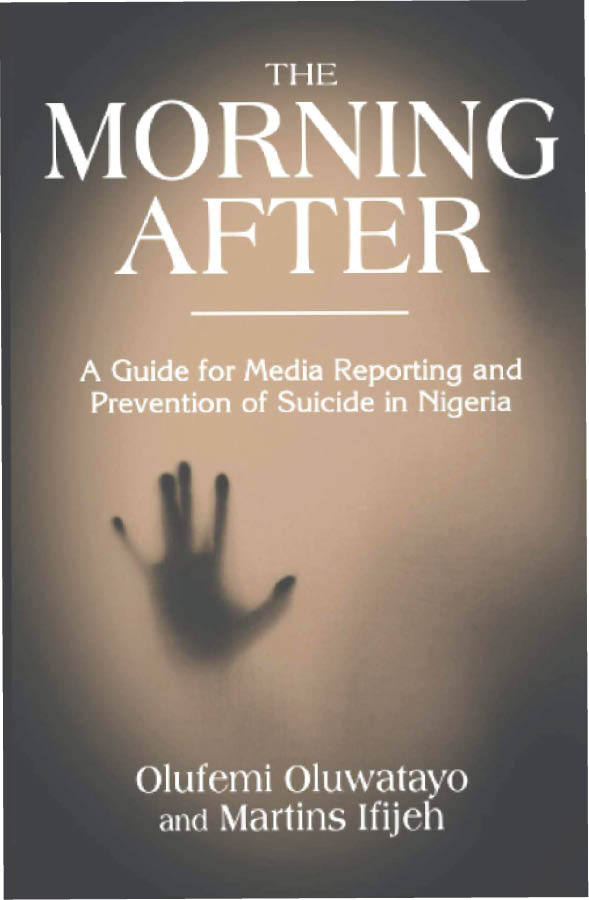Using the pen to make the pain go away
Suicide is a taboo in nearly every corner of Nigeria—regardless of religion and culture. That is also the reason it breeds intense fascination in media reporting

Using the pen to make the pain go away
Title: The morning after: A guide for media reporting and prevention of suicide in Nigeria
Authors: Olufemi Oluwatayo & Martins Ifijeh
Pages: 137
Chapters: 9
Publisher: Prima
Some were students, some were family heads. The only common thread was that they were found and quickly labelled suicide. And then the media frenzy begins: 300 words on news pages rake through their life, headlines speculate reason, weekend features rake through the grief and confusion the bereaved family is thrown into.
- Doubts trail Boko Haram claims on missing NAF fighter jet
- Why we want drug test for politicians, students – Marwa
Suicide is a taboo in nearly every corner of Nigeria—regardless of religion and culture. That is also the reason it breeds intense fascination in media reporting. But has the media been getting it wrong all this while? A new book, The morning after: A guide for media reporting and prevention of suicide in Nigeria is sure about that.
Co-authored by consultant psychiatrist, Dr Olufemi Oluwatayo, and award-winning health journalist Martins Ifijeh, the book does not object to media reporting suicide but proposes how it can better report the shocking end to one life’s by one’s intention and what consequences that has for grieving families left behind.
Nigeria in particular has no hard and fast guidelines for reporting suicide, but there are best practices around the world. The authors provide a compendium of practices that make for guidelines going forward.
Very telling is the reality that suicide is still considered a crime and most often reported as a crime. Those who survive are treated as outcasts and suffer psychological effects, the authors say.
In most publications, the source of the story is usually a crime reporter. That’s where things tend to go wrong. Suicide is a public health issue and should be treated as such. Reporting it should be a vehicle to educating the public on mental health issues, like depression, associated with suicide.
That message comes clear through the 137 pages of the book, and feeds into the condensed guidelines for the media. It highlights the impact of poor reporting of suicide on families. The authors follow up on families named in suicide stories to see how they have been affected. Shattered is the best description for families dragged through the press after having a loved one end their life.
So how can the media make the experience less harrowing? For one, ease up on the sensational and bleeding. It doesn’t always have to be “man bites dog” making the news. Avoid the word “suicide” in any part of the report: it is stigmatising and arouses strong negative emotions.
“Those emotions distort ability to be objective in taking in an analysing the story,” according to the authors. “Found dead” is a better alternative. There are so many factors with regards suicide—it is not a single cause-and-effect action but the culmination of several factors over time leading to an event.
Another word to avoid is “commit”. The word suggests a crime has been committed and the person is criminal. If it is inevitable to do away with “suicide”, then “completed” should replace “commit”.
Avoid repeating the stories—there should be no need for updates, new angles, anything to give the story legs. And there’s no need to place the story in any prominent part of the paper or news broadcast. No need for front cover; inside pages and tail end are fine.
If the story even has to be told, there is no need to include personal details of the person involved, including names and photographs, and explicit description of the method used. Some writers go overboard on details to beat the competition but this is not necessary.
This is especially because, pouring out details of a completed suicide fuels copycat suicides. “The danger in reporting the details of the method used in a completed suicide is that it may provide a suicidal person good information on what is lethal and what works well,” the authors say.
While at it, media should treat the deceased with dignity and be sensitive to the feelings of grieving families. Very importantly, each report should include information on how to get help for individuals having suicidal thoughts. It should also be an opportunity to educate the public on suicide and mental health.
Of course that would mean putting the right pegs in the right holes. The authors suggest leaving suicide reporting to health journalists, or at least training all journalists—if they are not health journalists—on the guidelines.
Bereaved families spoken to in the course of the book continue to feel the stigma of their loved ones’ suicide, “especially when the media contributed to the pain”, the authors say.
“But the same media can make the pain go away if suicide stories are reported in a more professional manner. As the saying goes, the pen is mightier than the sword. It is time that journalists use it to save lives and play its role in preventing suicides.”
